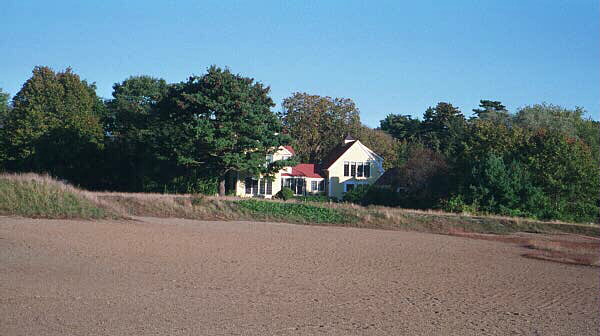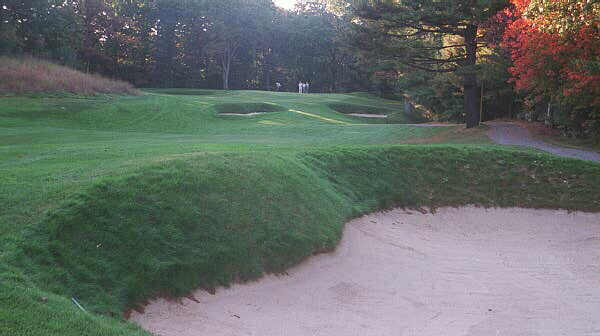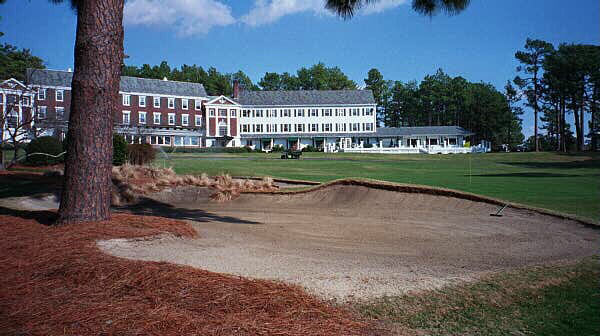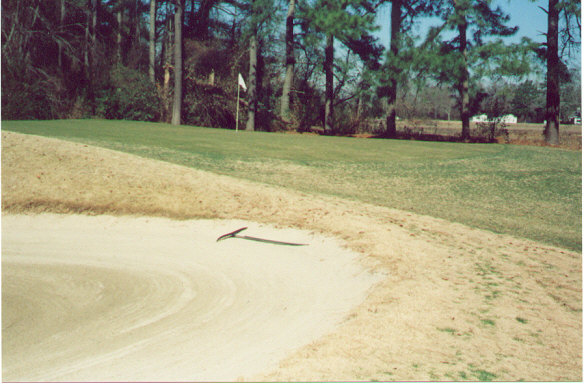Feature Interview with Khristine Januzik
April 2001
Khristine Januzik began working at The Tufts Archives in 1993, having never played golf in her life and still referring to the game as ‘Pasture Pool.’ Part of the job description included giving history programs and talks to various Pinehurst area groups. Donald Ross was very much a part of that history.
Having encountered the late Pete Jones through his lengthy phone calls and his occasional visits to the Archives, Khris became interested in the architectural and maintenance side of golf. As calls from architects, superintendents, writers and committee members became more frequent, Khris realized the need for accurate indexing, cataloging to facilitate retrieval of the Ross drawings and other historical documents relating to golf.
Khris attended her first Donald Ross Society dinner in 1994 the night that a panel discussion was held between Tom Doak, Ron Forse, Ron Prichard, Ed Connor, Arthur Hills & Michael Young, moderated by Brad Klein. The topic was ‘ Restoring a Donald Ross Course – What does it Mean Today?’ That was it, and she has been hooked ever since.
Khris took over from Pete Jones in 1998 as an Honorary Board Member for the Ross Society. More importantly, Khris survived the US Open – Pinehurst 1999 and still has not played golf!
1. What is the mission statement of the Archives?
The mission statement of the Archives has recently been expanded by the Board of Directors to include the collection and preservation of two dimensional and three-dimensional material related to Pinehurst, its founding, growth and development; Pinehurst golf; the life and work of Donald Ross and golf course architecture and maintenance.
2. What is contained in the Archives?
The Tufts Archives houses photographic collections totaling 115,000 photographic negatives, about 40,000 prints, 7,000 slides and transparencies – over 1,250 files pertaining to golf; original and copies of original architectural drawings representing 182 courses (nearly all are the work of Donald Ross & Associates) as well as original ledgers, postcards, maps, and artifacts. About 1/2 of the collections pertain to golf and the other half to the founding and development of Pinehurst and the Tufts Family. We also keep a small library of books dealing with golf architecture and maintenance.
3. What were Donald Ross’s first two years like in Pinehurst?
His first two years were primarily devoted to teaching golf, giving exhibition tournaments with other Pros who came through Pinehurst and being in charge of the ‘Golf Equipment’.
His business was to promote and encourage guests to play golf. Even though the phrase ‘ In charge of the golf equipment’ conjures up visions of Donald Ross standing behind a counter renting out clubs and balls that’s not what the phrase means. Interestingly enough the term ‘Golf Equipment’ in those days included the Pinehurst ‘Golf Links’. So he was in charge of the golf course and all that went along with it. His brother Alec came along with him and the two were advertised as ‘notable pros at Pinehurst’.
They were given room and board and a salary and a percentage of the golf business. The first couple of years it appears that Donald had a room above the Department Store and took at least some of his meals at the Casino. (Don’t get excited, the Casino wasn’t what you would think it was today! The wildest thing happening there would have been a coed game of Whist with absolutely no wagers!)
In a nut shell he would have spent most of his time tweaking the #1 golf course and promoting the game.

Ross lived in this house beside the 15th hole at Essex County in Massachusetts during the hot Pinehurst summers.
4. As you gathered information from around the country, has there been a single particular surprise that really stands out?
As far as surprises go, there are a couple of things that are to me very intriguing. They are not really related to each other.
The biggest surprise to me was that in the 1920’s they (Ross, Maples & Tufts) were experimenting with the sand greens at Pinehurst, trying to give them more of a feel of turf which they were having a devil of a time growing ( that’s another story). They tried putting a thick heavy layer of sawdust under the top sand of the greens. The idea was that the sawdust would give the green some give or bounce I guess you would say as if the ball were to land on turf rather than the hard packed sand. Other clubs in the south were trying different things like cotton bowls and peanut hulls. It did give the green more give, but the problem was that every time it rained hard the sawdust would work its way to the top of the sand and it was too labor intensive to have to keep repairing it.
It amazes me the lengths they went to develop turf here.
The other thing that surprises me is the list of ‘golf people’ who used to come through here in the very early days. There were several of Tillinghast’s friends, Crump was here before Pine Valley ever got started, Aleck Findlay, Ted Ray, etc. etc. and I would say that most of them played golf with Donald and Alec Ross while here. I know that Johnny Mc Dermott played paired with Donald Ross in 1913 after having won the 1911 & 1912 US Opens…Ross & McDermott won.
5. Without having seen the course, you remarked once that Salem CC must have some of Ross’s most intricate greens. How did you know?
It was the detail in the ‘field sketches’. It showed various elevations around the green and there were specific notes on the card for each of those elevations. They were specifically marked as A, B, C etc. rather than just fine little lines indicating elevation changes as we see in most of the drawings. To me it seemed that he had very specific ideas for those greens and was more detailed in his drawing and instructions.

The 13th at Salem is capped off by what some consider to be Ross’s single finest green.
6. Based on all the letters and notes that you have read from Donald Ross himself, how would you characterize the man?
Briefly I would say that he was VERY loyal to his friends, a loving family man and devoted father; hard working and fair but firm with employees. He had no use for slackers and was not at all impressed by young people who lived off their family fortunes to maintain an amateur status in golf or tennis in order to be the big fish in the little pond rather than taking the chance of going pro and being the small fish in the big pond and proving just how good (or not) that they really were.
Contrary to something I read written recently that attributed Donald Ross with being ‘exciting’ in contrast to the Tufts, I would really have to disagree. He simply went about the business of living and working in what would have been a very normal manner to him. His daughter told me that there was no feeling of ‘fame’, he was just her father. His accomplishments would not seem out of the ordinary to him because he would never have thought to do any less. It just sort of went without saying. He was ‘just’ a very solid, principled man, no scandal.
7. Pine Needles has attracted a lot of attention as the result of hosting one Women’s US Open already and is preparing to do so again this May. How did Ross view Pine Needles and Mid Pines relative to one another?
I have never seen anything yet where Ross discusses the two directly but….. judging from what the early advertisements of the two courses say and you know he had a hand in what was written about them; I would say that Pine Needles was to be the Championship Course while Mid Pines was to be the more relaxed, fun course. Again, Mid Pines would offer strategic challenges and opportunity for all kinds of shots so that it would not be boring. Pine Needles is touted as more of a challenge. This might have been in part due to their differences in topography. Ross had free reign in where he situated these courses. Mid Pines sits in a lower, protected bowl where Pine Needles is for a large part up on a higher elevation.

The Home Green at Mid Pines.
Before I knew which course it was, I looked at an untitled routing for Pine Needles and said ‘ gee, that is really unusual for a Ross course!, Look at how elongated and spread out it is, and all the house lots. I wonder what he thought of doing that?’ Which only goes to show, you have to be very careful about making statements about Ross, like ‘ His greens are this way or that and he always did his routing this way.’ I wouldn’t say he ever ‘always did ‘ anything. Mid Pines is a nice compact routing, it served its purpose, Pine Needles was an elongated double loop of nine and it served its purpose. It enhanced a real estate venture. He had free reign, and I dare say some interest in the venture so he designed for the occasion.
8. What was the Tufts Family relationship with Donald Ross?
Their relationship was very definitely a business one. But you have to factor in the amount of years covered by that relationship and what was accomplished during that time. It’s not just a cut and dried thing. The Tufts family, the Maples family and Donald Ross built something together. They truly created something. If you removed any one of them from the equation I am sure you would have a totally different picture today. I am sure there were ups and downs in the relationship, it probably could be compared to a marriage in a way. The sum of the parts together were definitely greater than they would have been individually. This was a relationship that lasted nearly fifty years and Donald Ross was godfather to Peter Tufts. That has to say something.
9. What do you know of the Pine Crest Country Club in Lumberton, NC?
I don’t have a lot of hard, primary evidence for this course yet. There hasn’t been the time to really dig into it. I do have the history written by Mr. Biggs and I have walked the course.
Ya’ just gotta’ love a course that is built by dragging a broken piece of grading equipment behind a tractor! Somebody sure wanted to play golf there! I have found that a Dick Wilson was in Pinehurst around the time that he was supposed to have been involved with the Pine Crest course.
One of these days I would love to really dig into this course’s history and back up the history with primary evidence if it exists. Anyway, it’s a delightful course and however it really came about and who ever had a hand in it, well it’s just a nice place to be and definitely a good walking course, probably one of the better kept North Carolina secrets. It deserves attention.

The original greens at Pine Crest are difficult to hit as they are pushed-up and slope away on all sides.
10. Who are some of the most thorough researchers that you have witnessed at the Tufts Archives?
The most thorough researchers I have seen and worked with at the Archives are Brad Klein, Ron Whitten, Bob Tufts and Lee Pace. They have been very professional and focused . They do their own research and worked with original material, not just relying on what anyone else said….real research. They each spent a good deal of time in the Archives utilizing all collections and not just what was printed in the newspapers. I think it shows in their work.
11. What is the current status of the Archives?
Tufts Archives suffers from the lack of space, but not just any space, the environmentally controlled space needed to preserve and conserve materials properly. Storage space that is climate controlled is desperately needed. Space is definitely needed for many more sections of flat files so that architectural drawings can be stored flat, with support boards and acid/lignin free portfolios, all that technical archive talk… Then there are the photographs and negatives, they need a world of their own.
They are deteriorating at a fast rate now, and they are so important. They are the visual archeology of a very significant part of history. Massive funding is needed to duplicate prints and negatives before they are beyond repair and restoration work needs to be done on significant negs and prints that have deteriorated.
12. What is the first priority of the Archives?
First off the photo collection has to be stabilized and funds raised for its preservation, then we are looking at the need for funds to obtain adequate building space. A lot of folks have a lot of ideas of where we should find space, but they are unaware of the type of space needed and all of the special requirements that a well provided for archive needs. So it all has to be planned out carefully or we are only trading one set of problems for another.
13. How does one use the Archives?
Requests for information may be made by phone, mail, e-mail (although currently we do not have e-mail in the Archives so you would be e-mailing me at home which means there would be a bit of delay) or you can certainly come in and request information in person and or do your own research. Due to the nature of original works and aged paper some material is restricted and is not copied for just any one or any reason. But you can view restricted material and take notes and some copies will be done on written request. It depends on the reason for the request and the material. If you are coming to the Archives and want to spend some time studying and researching it is best to call ahead so that we can make sure that you are not trying to delve into complicated historical documents when there are grade school classes or a senior’s touring group in the museum area! It also gives me a chance to retrieve materials from the basement that you might also be interested in.
If I do an in-depth and extensive search for you there is a $50.00 per hour charge. But things are getting to the point of being so well cataloged that most information can be pulled up with a simple index search right over the phone for which there is no charge.
14. What are some of the current projects at the Archives?
A catalog made up from all of the various data base indexes developed in the Archives over the last few years is being put together in html format. The golf portion will be the first completed. It is hoped that someday it or a portion of it will be available as a web site. At any rate it will be available at the Archives for researchers. It also makes searching for phone requests very quick and complete as all of the various collections are combined where the indexes were separate for each collection. The Ross Society is funding an intern to evaluate and catalog the W.P. Jones collection which has already been organized and indexed. Pete Jones was the former historian for the Ross Society and the Archives received his document collection after his death.
Doug Lewis who is currently employed as my assistant until he goes back to being a golf course superintendent (what else do you do with a history degree if you don’t want to teach and you love golf?) on Mackinac Island, MI when the spring thaw hits (which may not until August this year!!) is cataloging documents on turf development, course maintenance and Donald Ross’s correspondence. Most of the documents he is working with are correspondence between Pinehurst ( the Tufts), DJR and Frank Maples. It is amazing how many things we take for granted got started right here in Pinehurst and how much of a contribution Pinehurst has made to the game of golf over its 100 plus years of history.
15. What are some of the better discoveries coming out of these projects?
These projects are helping to fill in pieces of the overall view puzzle. Sometimes it appears that there is a conflict in information when in reality a missing piece if information would complete that part of the picture and show that the pieces are not in conflict at all. It is enthralling to see how things developed. We forget that Donald Ross, Leonard Tufts and Frank Maples were all just ‘normal’ people playing out their lives in what they would have considered their own normal ways. I don’t believe that any of them considered that in fifty plus years would be making a fuss over them or considering them famous. They were really interested in getting the best job done in the best way. There is no way to cut them out with a cookie cutter, they were influenced by all kinds of people. Ideas had to flow back and forth, these documents bare that out. When you look at the cast of characters that appeared in Pinehurst on a regular and not so regular basis and consider what the golf industry was like in its American infancy, it’s hard to imagine that Walter Travis, Alex Findlay or Jack Jolly NOT making suggestions and comments about the course(s), for sure Gladys Ravenscroft did. So how could Donald Ross have lived and worked in a vacuum, impervious to the ideas of those he had dinner with, played golf with and socialized with etc.? I would have loved to have been a fly on the wall at the Holly Inn in those days.
16. How important is the history of Pinehurst in general?
I would say that it is very important, even if you are only interested in the golf end of things because the threads of golf history run through all of the other aspects of Pinehurst’s history. It is very difficult to separate them.
It is rare that we have such a detailed look at the development of a town and all that went into its founding and growth. Pinehurst’s history is a time capsule, a microcosm, and a look at social history that reflects what was happening in the rest of the world.
17. Who uses the Archives?
Our patronage is widely varied. We hear a lot from architects who are involved in remodeling or restoring Ross courses. They are usually looking for architectural drawings. We hear a lot from club historians as we go through that time period when a lot of the clubs are reaching their 100th or 75th anniversaries and they are publishing their club histories. We provide photographs for magazines and do fact-checking for them. We have done research for and provided photographs for documentary videos, books and even done research for a motion picture. We see members from various Ross courses who are in town and want to get a look at their original drawings. We have had visits from the British Institute of Golf Architecture and one of my favorite groups is the History of Golf Architecture Design class from the Sandhills Community College’s Turf Grass Management program who research here for their term papers. On rainy days I’ve had visits from superintendents and rained out visitors. There is the general foot traffic who comes to view the small museum area we have and they are usually comprised of guests at the Resort’s hotels or guests of village residents. We also see a lot of people who have just moved into Pinehurst who want to know the history of their houses, especially if they are trying to restore it. We do work for the Resort and for the Village as well…then there are the state’s Department of Tourism, Sports Development and Film and the local Convention and Visitor’s Bureau…… in other words, give me five minutes and I’ll find something in the Archives that will interest you, even if you are not interested in golf.
18. How is the Tufts Archives funded?
The Archives is currently funded from interest on a combined endowment with the Given Memorial Library and what is raised in the annual fund drive, publication and support fees charged, research fees and donations. As generous as our donors are, the current funding is not adequate to support needed staff, space environmental control and materials to maintain the collections in optimum condition.
19. What do you personally want for the Archives?
I would like for the Archives to be recognized for its significance by enough people to insure its continued existence. In light of what has happened with the Ralph Miller Library it makes one take notice. The Tufts Archives is a very unique institution. There are very few out there.
Massive funding and a new building would be the ultimate.
On a day-to-day reality basis, enough time to get all caught up on collection work and cataloging before the next US Open hits.

The world’s best will once again face such difficult recovery shots in June, 2005. Pictured is the 1st green on Pinehurst No.2.
The End








